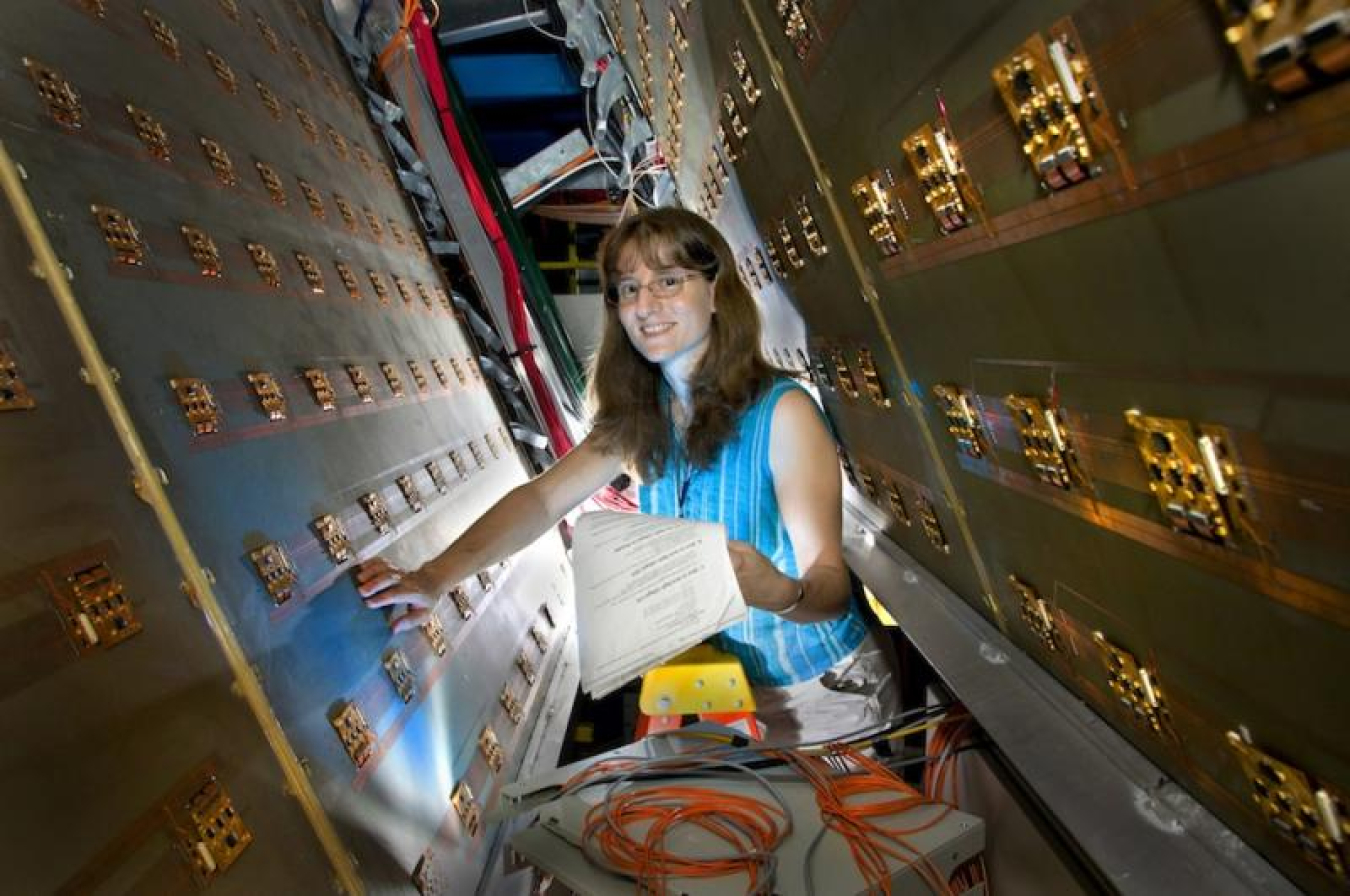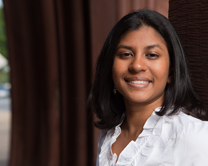A nuclear physicist hailing from Los Alamos National Lab, Christine Aidala is currently stationed at Brookhaven National Laboratory to be near her latest experiment at the Relativistic Heavy Ion Collider. We recently caught up with Christine and got th...
March 3, 2011
Christine Aidala, Nuclear Physicist, Los Alamos, National Laboratory. | Department of Energy Photo | Courtesy of Los Alamos National Laboratory |
A nuclear physicist hailing from Los Alamos National Lab, Christine Aidala is currently stationed at Brookhaven National Laboratory to be near her latest experiment at the Relativistic Heavy Ion Collider. We recently caught up with Christine and got the download on what it’s like working at the RHIC, the proton spin puzzle, and her favorite musical composition — but more on that in a bit.
Q: Why did you choose nuclear physics?
Christine Aidala: The summer after my freshman year in college, I knew I wanted to do research, and I ended up working in a low-energy nuclear physics lab at my school. I enjoyed it, and as one thing led to another, I spent the next few summers doing research in different areas of nuclear and particle physics. I first got involved in my current field of proton structure for my senior thesis as an undergrad, doing simulation studies as part of a proposal to polarize the proton beam at the HERA electron-proton collider in Hamburg, Germany. Unfortunately, the proton beam there was never polarized, but I was lucky to have the opportunity a couple years later to become involved in RHIC just as its polarized proton program was starting up.
Q: Tell us about the proton spin puzzle. What are you investigating? What do you hope it will lead to?
CA: We’ve known since the 1970s that the proton is made up of subnuclear particles called quarks. The simplest picture of the proton is that it’s comprised of three “valence” quarks. All particles possess a quantum property called spin. The total spin of the proton is 1/2 (in units of the fundamental constant h-bar). Since quarks also carry spin ½ people basically assumed that the proton’s spin was due to two of the valence quarks spinning in the same direction and the third in the opposite: ½ + ½ - ½ = ½.
A startling discovery at CERN in the late 1980s demonstrated that this wasn’t the case at all. Since then physicists have been trying to figure out how the subnuclear particles inside the proton do account for its observed total spin of ½ and we still don’t know. The proton’s spin, by the way, is what enables the medical technique of magnetic resonance imaging (MRI).
I’m interested in understanding not only the decomposition of the proton’s spin but other aspects of its internal structure. I find studying proton structure very appealing for two reasons. By studying the proton I’m investigating the strong force, one of only three known fundamental forces in nature (gravity and the electroweak force being the other two), so it’s research probing the basic foundations of our understanding of matter and how it interacts. However, while being very fundamental it’s also quite down-to-earth, given that protons are one of the main constituents of all the familiar, everyday matter around us, including our own bodies!
I personally fully expect technological applications to eventually come out of understanding the internal structure of the proton, perhaps not in my lifetime, but maybe by the end of the century. Thinking of the history of applications coming out of nuclear and particle physics, I’m sure the scientists in the 19th century who first created and accelerated beams of electrons never dreamed that we’d all have our own electron accelerators for personal entertainment by the 1950s in the form of something called television.
Q: Which projects are you watching (beside your own)?
CA: I’m quite curious to see what new physics will be discovered at the Large Hadron Collider at CERN in the upcoming years. The particle physics community has waited a long time for a new facility operating at the energy frontier.
Q: Do you have any advice for students interested in becoming scientists?
CA: I’d encourage students to take advantage of the tremendous number of resources out there today to explore science – a wealth of internet sites covering a myriad of topics, and many more interactive science centers and museums than there were just ten years ago. I also think it’s quite helpful to get involved in some kind of research early as this is going to give you the best idea of what it’s actually like to pursue science as a career. There are all sorts of research opportunities open to undergrads, and there seem to be an increasing number of opportunities available to many high school students as well.
Q: Did you have a teacher or role model who inspired you to become a scientist?
CA: My father was certainly a big influence. He’s an aerospace engineer, and he turned lots of everyday experiences into opportunities for my sister and me to learn about science. She, in fact, became a physicist as well.
Q: What is your favorite thing about being a nuclear physicist?
CA: One of the aspects I enjoy the most is working as part of such an international community. Having face-to-face interactions with people from dozens of countries around the globe has given me a completely different perspective on world events. Seeing individuals from nations in conflict working enthusiastically side by side on a common project has inspired hope in me that science can be a means to work toward global peace. Human curiosity recognizes no political boundaries.
Q: What is it like working at RHIC?
CA: It’s a very exciting facility to be working at, with so many unexpected results that have come out over the ten years that it’s been running, pushing scientists to rethink assumptions and hypotheses and come up with new ideas. Due to the huge scientific impact that RHIC has had, BNL was recently ranked as the number one institution in the world for hadron collider research.
Q: What can you never start a day at the lab without?
CA: Checking email! Working in collaboration with more than 500 people from institutions in 14 countries, our main means of communication are through a variety of email list servers focused on different aspects of the experiment. And with collaborators across so many time zones, the messages don’t slow down while those of us in New York are sleeping!
Q: If you weren’t a scientist, what would you be?
CA: I’d be a science journalist. With science and technology playing such a tremendous role in society, I think it’s important to try to raise the level of scientific discourse and scientific literacy in the U.S.
Q: We heard that you are an accomplished musician. Which instruments do you play? Do you have a favorite composition?
CA: I consider myself primarily a clarinet and bassoon player. I started both instruments in elementary school and continued the two of them intensively through a Bachelor’s in music (a double major with physics). I also “double” on saxophone and flute, which I originally picked up in junior high. My favorite piece is Aaron Copland’s Clarinet Concerto.
Find out more about Dr. Aidala and other projects at BNL at www.bnl.gov.
This is the latest post in our 10 Questions series, introducing you to our scientists and the incredible work they do. You can view our last post featuring Pacific Northwest National Lab scientist Praveen Thallapally here.


